Abstract
Results of basic research have demonstrated that behavior maintained on an intermittent schedule of reinforcement (INT) will be extinguished more slowly than behavior maintained on a continuous schedule (CRF). Although these findings suggest that problem behaviors may be difficult to treat with extinction if they have been maintained on INT rather than on CRF schedules, few applied studies have examined this phenomenon with human behavior in clinical settings. The purpose of this study was to determine whether problem behavior maintained on CRF schedules would be extinguished more rapidly than behavior maintained on INT schedules. Three individuals diagnosed with profound mental retardation participated after results of pretreatment functional analyses had identified the sources of reinforcement that were maintaining their self-injury, aggression, or disruption. Subjects were exposed to extinction following baseline conditions with CRF or INT schedules alternated within reversal or multielement designs. Results suggested that problem behavior may not be more difficult to treat with extinction if they have been maintained on INT rather than CRF schedules. However, switching from an INT to a CRF schedule prior to extinction may lower the baseline response rate as well as the total number of responses exhibited during extinction.
Full text
PDF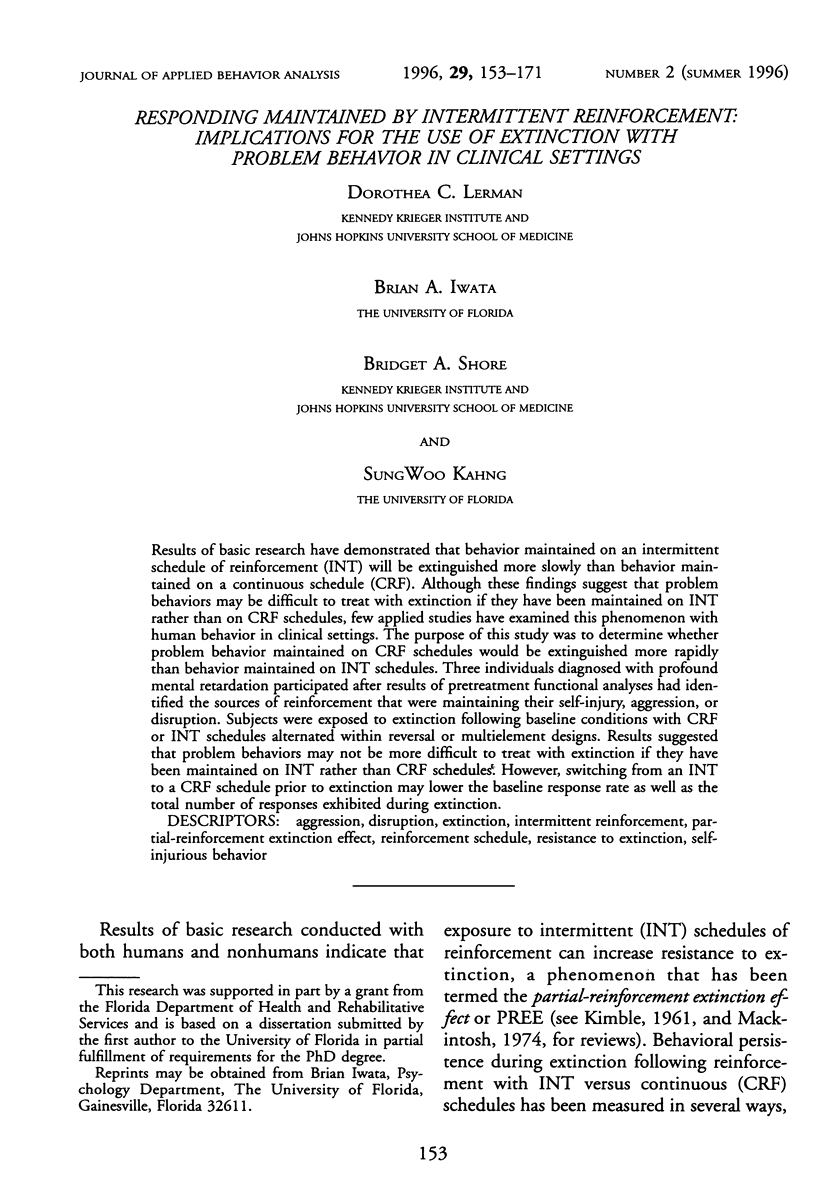
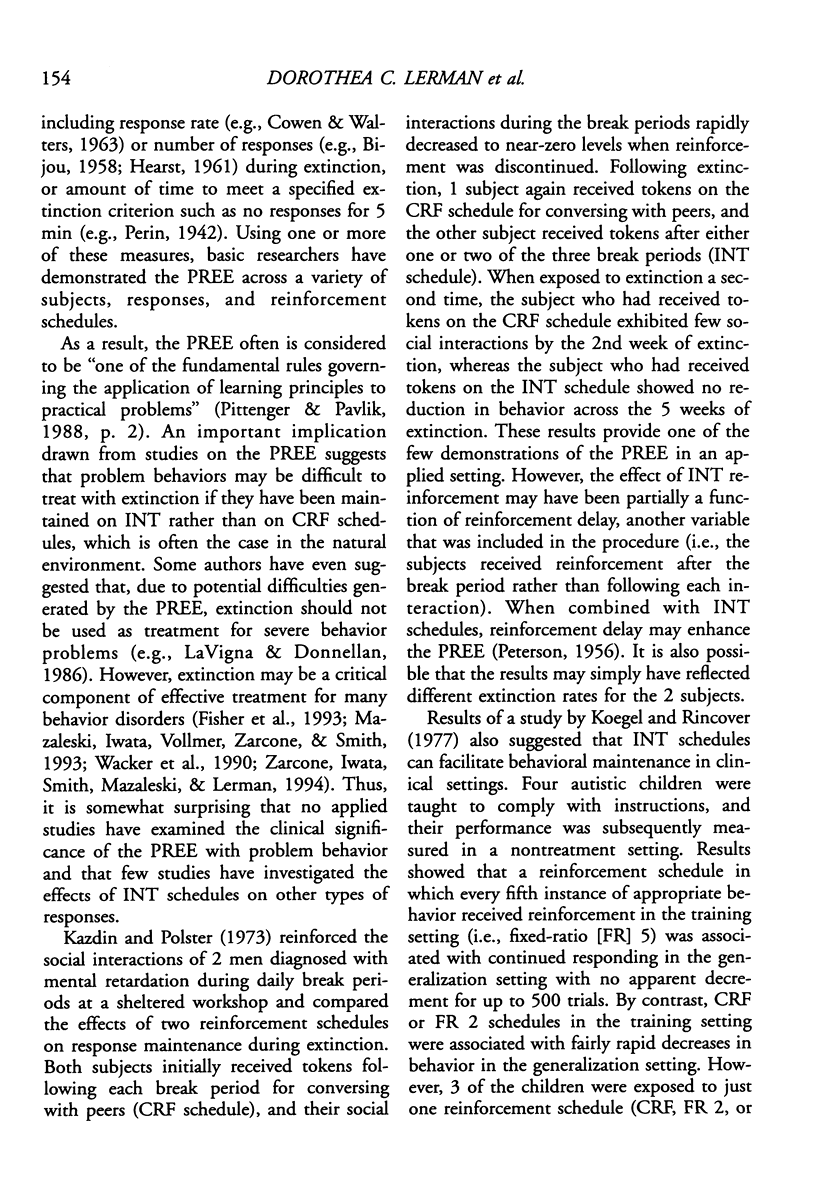
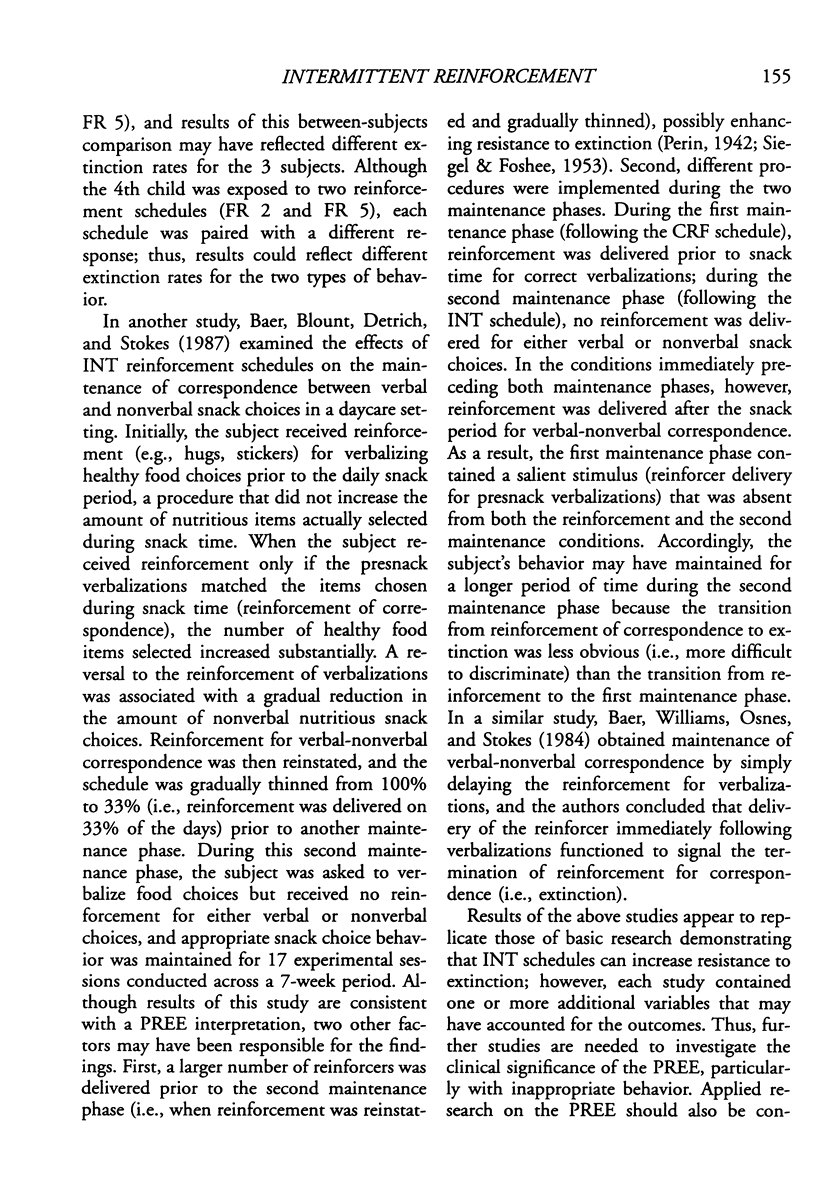


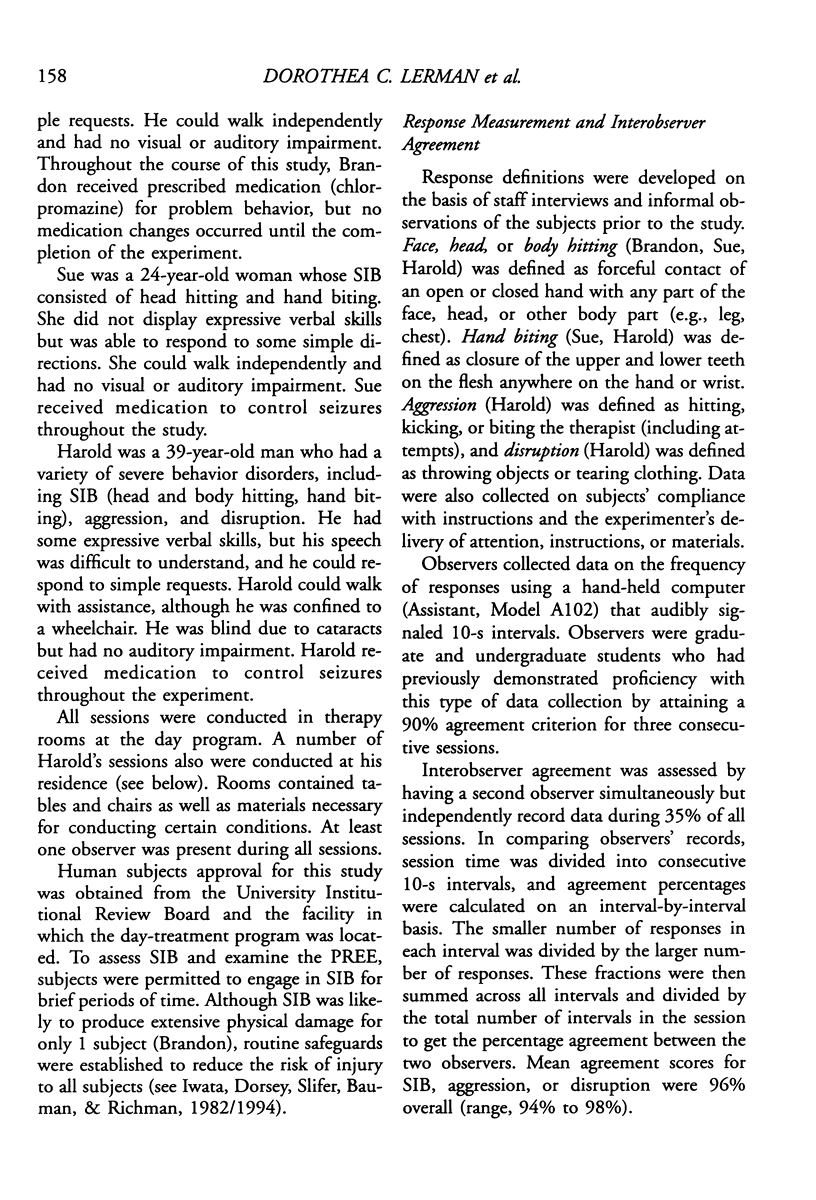
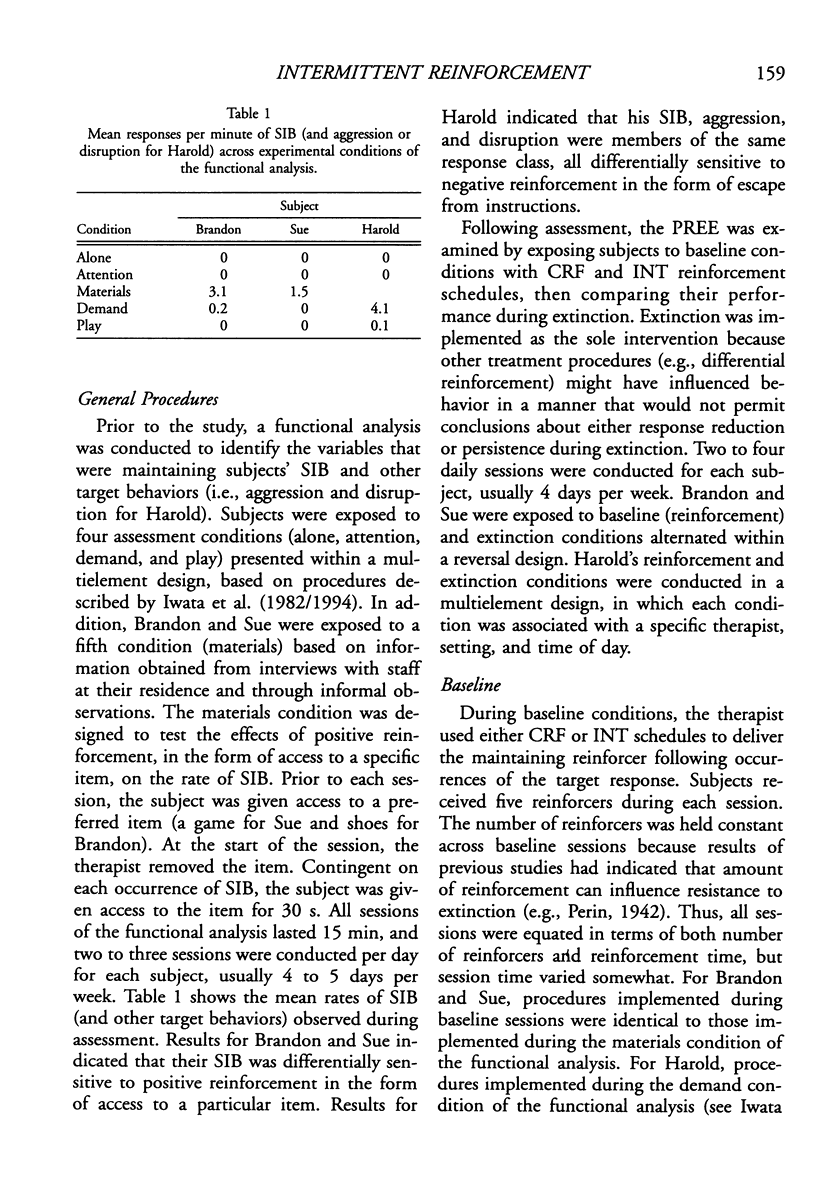
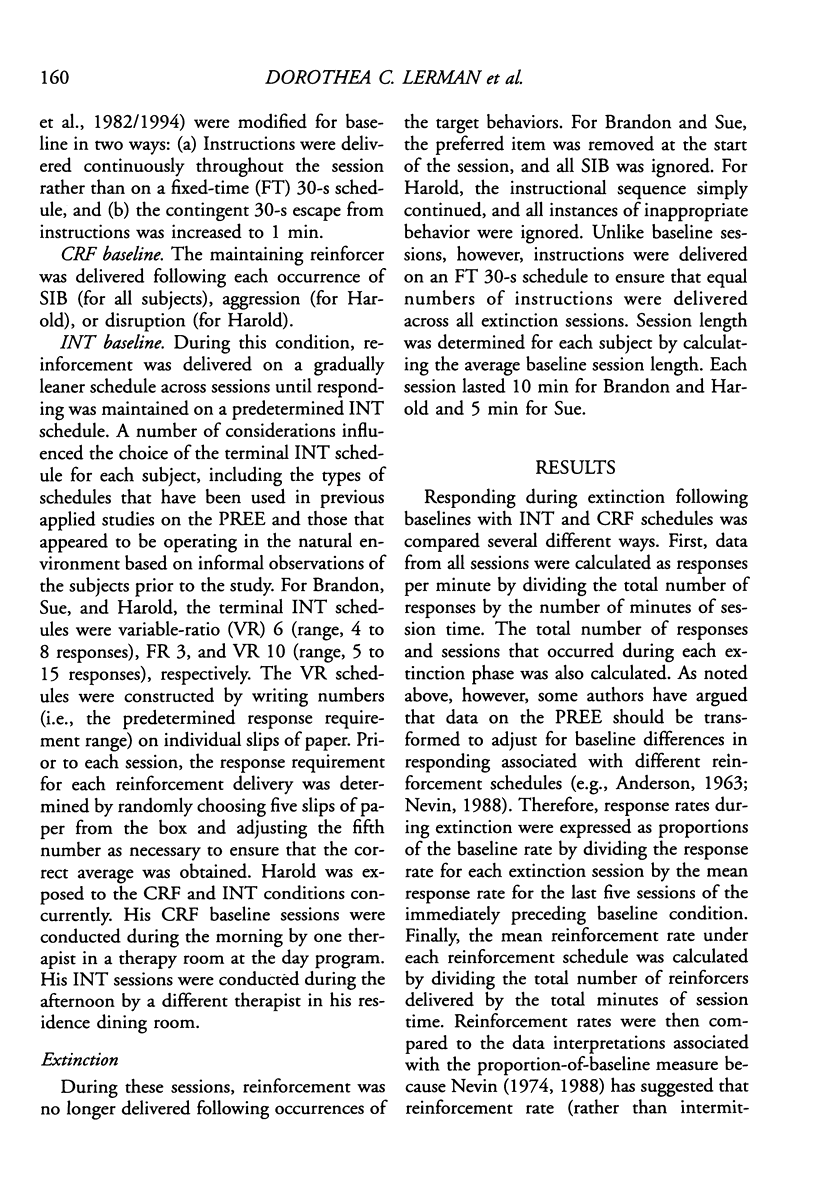
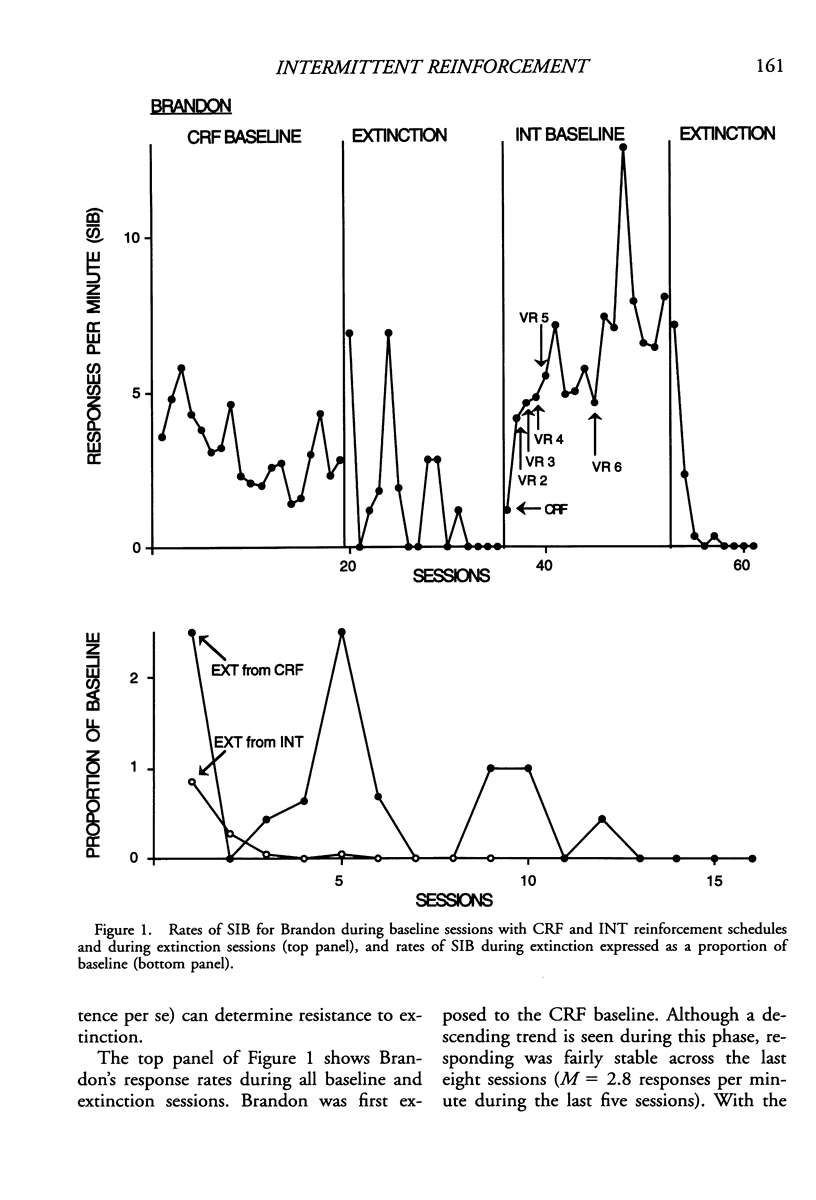
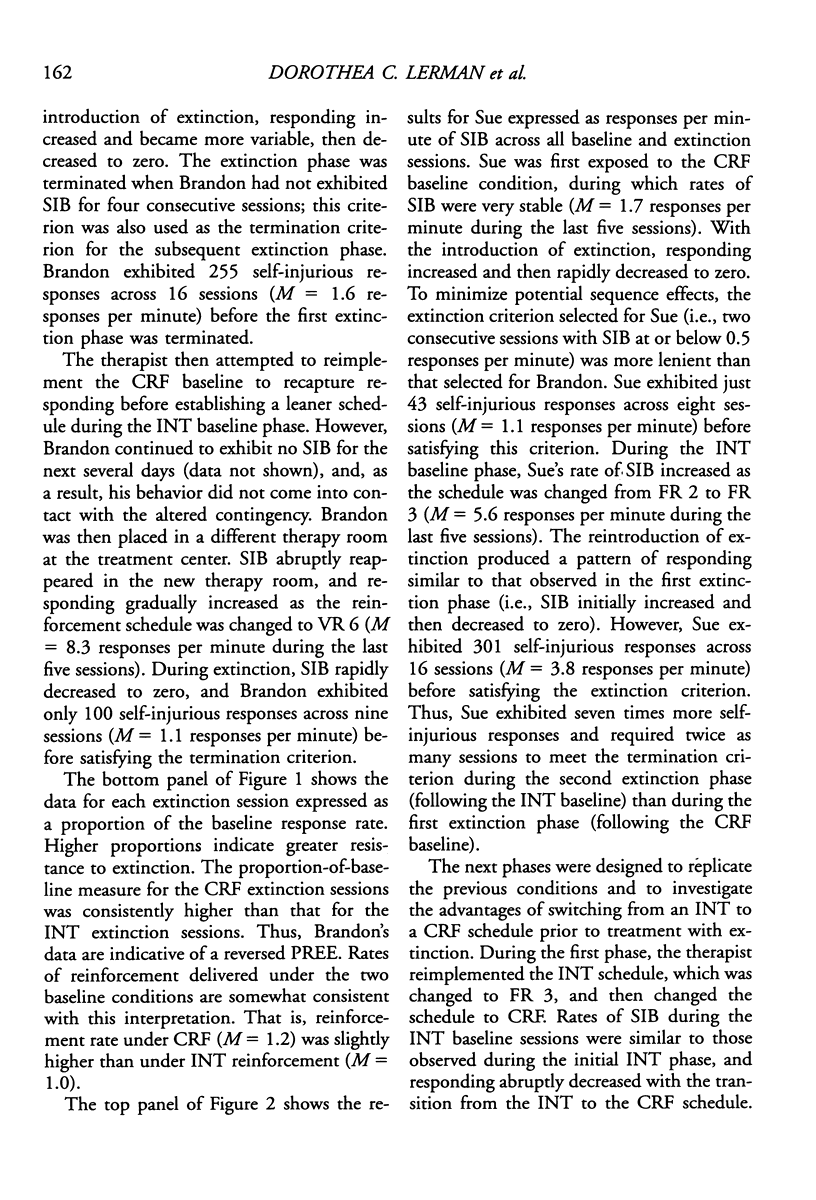

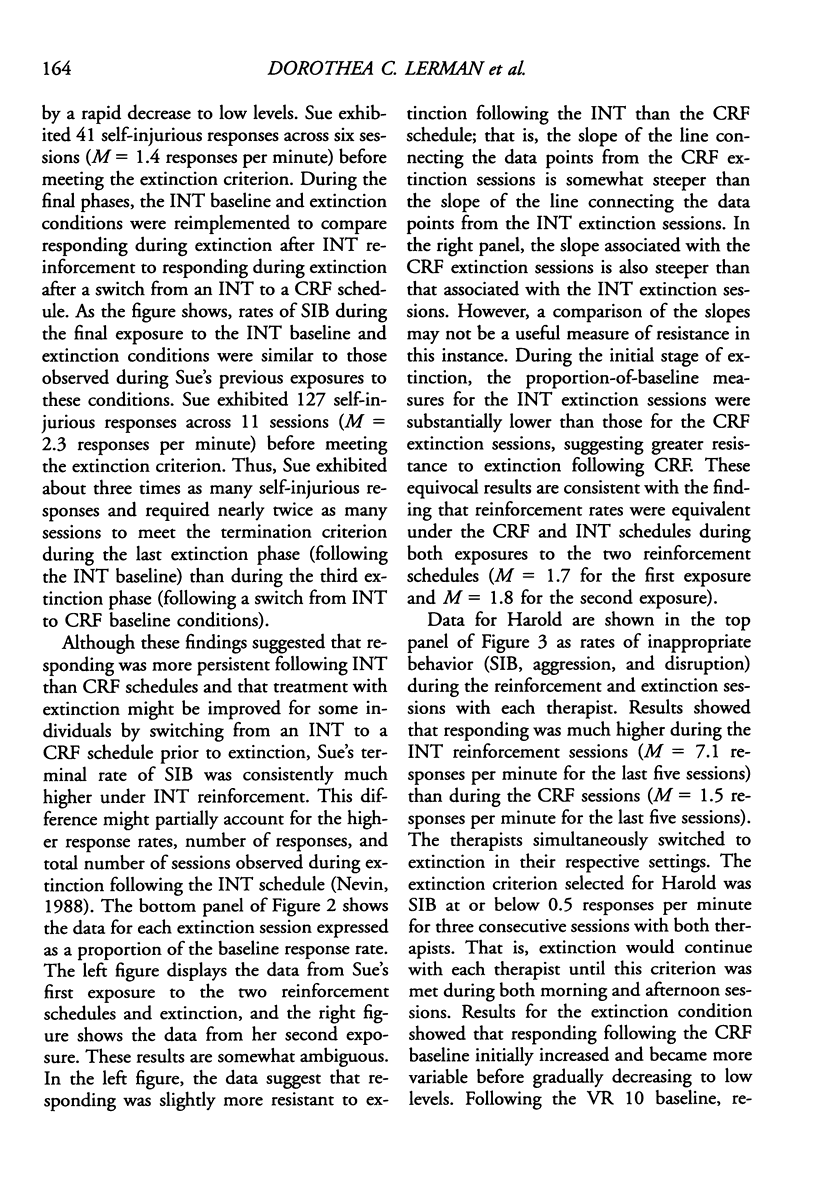
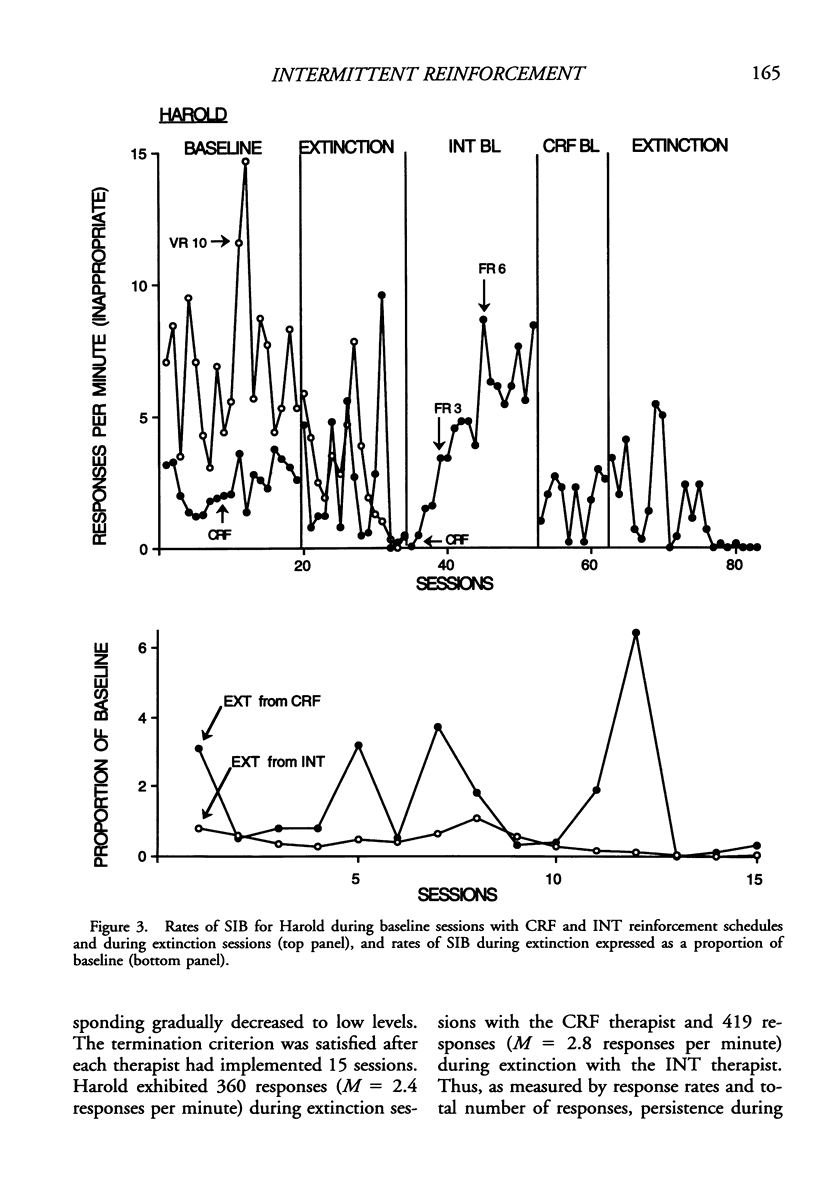
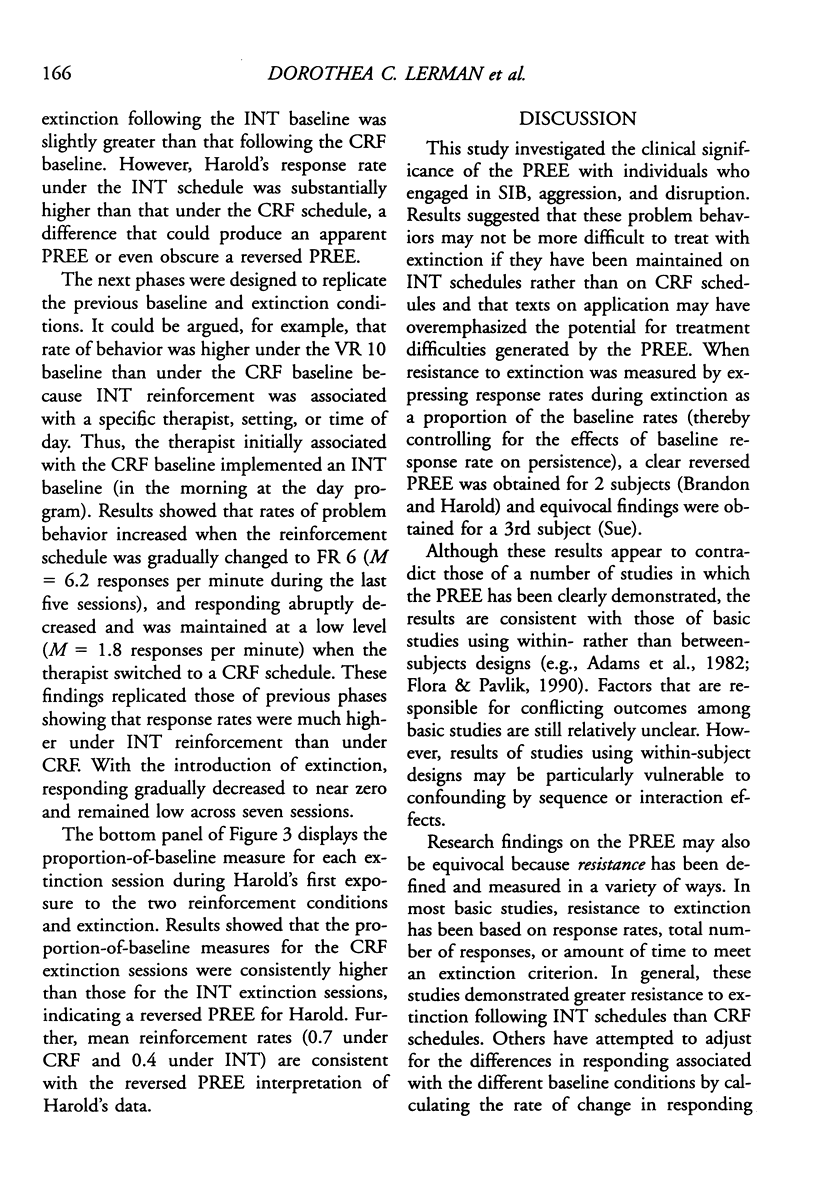
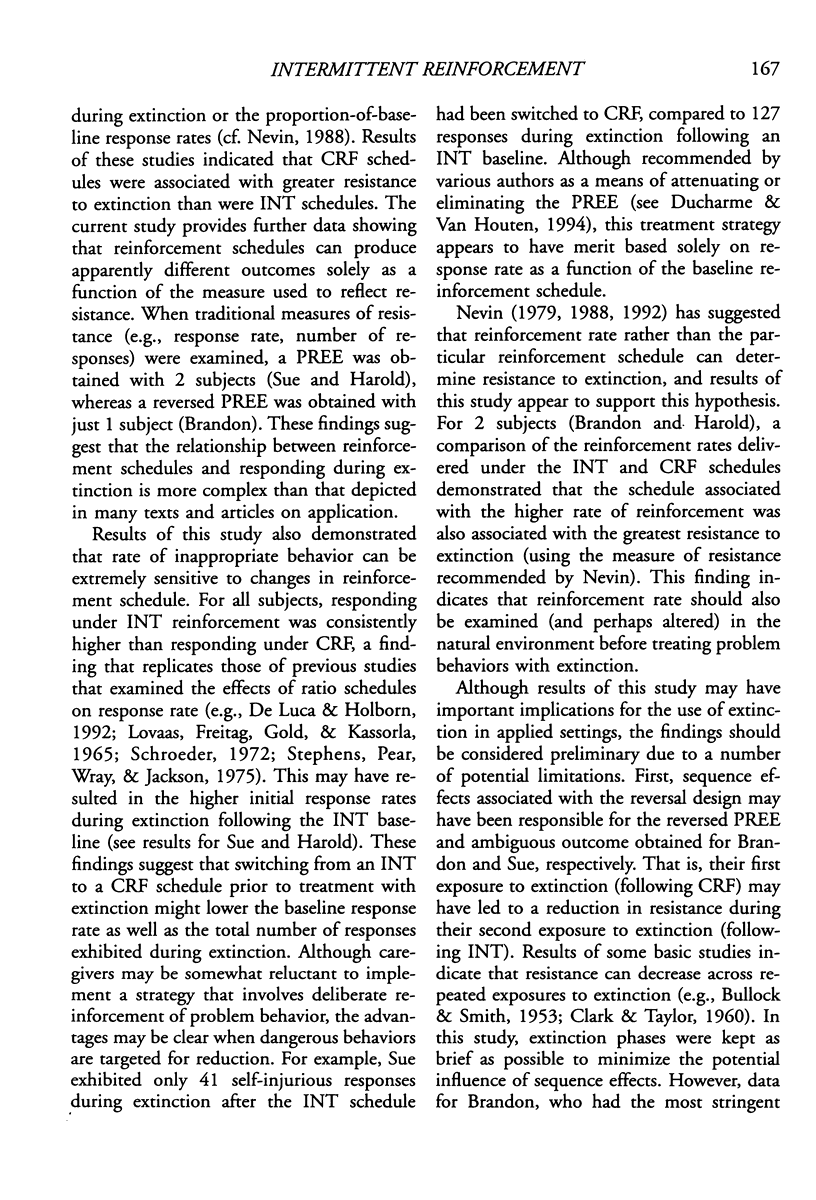
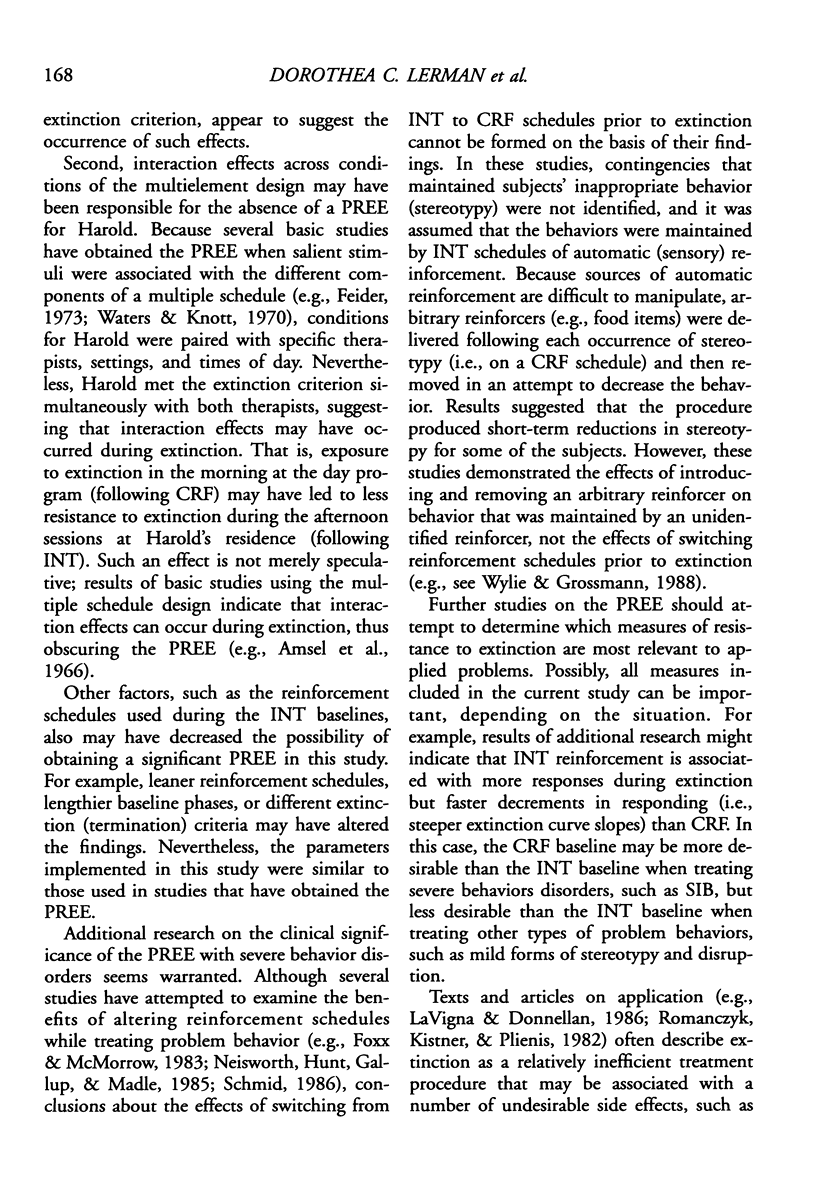



Selected References
These references are in PubMed. This may not be the complete list of references from this article.
- ANDERSON N. H. Comparison of different populations: resistance to extinction and transfer. Psychol Rev. 1963 Mar;70:162–179. doi: 10.1037/h0044858. [DOI] [PubMed] [Google Scholar]
- Amsel A., Rashotte M. E., Mackinnon J. R. Partial reinforcement effects within subject and between subjects. Psychol Monogr. 1966;80(20):1–39. doi: 10.1037/h0093898. [DOI] [PubMed] [Google Scholar]
- BULLOCK D. H., SMITH W. C. An effect of repeated conditioning-extinction upon operant strength. J Exp Psychol. 1953 Nov;46(5):349–352. doi: 10.1037/h0054544. [DOI] [PubMed] [Google Scholar]
- Baer R. A., Blount R. L., Detrich R., Stokes T. F. Using intermittent reinforcement to program maintenance of verbal/nonverbal correspondence. J Appl Behav Anal. 1987 Summer;20(2):179–184. doi: 10.1901/jaba.1987.20-179. [DOI] [PMC free article] [PubMed] [Google Scholar]
- Baer R. A., Williams J. A., Osnes P. G., Stokes T. F. Delayed reinforcement as an indiscriminable contingency in verbal/nonverbal correspondence training. J Appl Behav Anal. 1984 Winter;17(4):429–440. doi: 10.1901/jaba.1984.17-429. [DOI] [PMC free article] [PubMed] [Google Scholar]
- Bijou S. W. Operant Extinction after Fixed-interval Reinforcement with Young Children. J Exp Anal Behav. 1958 Jan;1(1):25–29. doi: 10.1901/jeab.1958.1-25. [DOI] [PMC free article] [PubMed] [Google Scholar]
- COWAN P. A., WALTERS R. H. Studies of reinforcement of aggression. I. Effects of scheduling. Child Dev. 1963 Sep;34:543–551. doi: 10.1111/j.1467-8624.1963.tb05158.x. [DOI] [PubMed] [Google Scholar]
- Carr E. G., Newsom C. D., Binkoff J. A. Escape as a factor in the aggressive behavior of two retarded children. J Appl Behav Anal. 1980 Spring;13(1):101–117. doi: 10.1901/jaba.1980.13-101. [DOI] [PMC free article] [PubMed] [Google Scholar]
- Cohen S. L., Riley D. S., Weigle P. A. Tests of behavior momentum in simple and multiple schedules with rats and pigeons. J Exp Anal Behav. 1993 Sep;60(2):255–291. doi: 10.1901/jeab.1993.60-255. [DOI] [PMC free article] [PubMed] [Google Scholar]
- De Luca R. V., Holborn S. W. Effects of a variable-ratio reinforcement schedule with changing criteria on exercise in obese and nonobese boys. J Appl Behav Anal. 1992 Fall;25(3):671–679. doi: 10.1901/jaba.1992.25-671. [DOI] [PMC free article] [PubMed] [Google Scholar]
- DucharmeJM, Van Houten R. Operant extinction in the treatment of severe maladaptive behavior: adapting research to practice. Behav Modif. 1994 Apr;18(2):139–170. doi: 10.1177/01454455940182001. [DOI] [PubMed] [Google Scholar]
- Fisher W., Piazza C., Cataldo M., Harrell R., Jefferson G., Conner R. Functional communication training with and without extinction and punishment. J Appl Behav Anal. 1993 Spring;26(1):23–36. doi: 10.1901/jaba.1993.26-23. [DOI] [PMC free article] [PubMed] [Google Scholar]
- France K. G., Hudson S. M. Behavior management of infant sleep disturbance. J Appl Behav Anal. 1990 Spring;23(1):91–98. doi: 10.1901/jaba.1990.23-91. [DOI] [PMC free article] [PubMed] [Google Scholar]
- HEARST E. Resistance-to-extinction functions in the single organism. J Exp Anal Behav. 1961 Apr;4:133–144. doi: 10.1901/jeab.1961.4-133. [DOI] [PMC free article] [PubMed] [Google Scholar]
- Iwata B. A., Dorsey M. F., Slifer K. J., Bauman K. E., Richman G. S. Toward a functional analysis of self-injury. J Appl Behav Anal. 1994 Summer;27(2):197–209. doi: 10.1901/jaba.1994.27-197. [DOI] [PMC free article] [PubMed] [Google Scholar]
- Iwata B. A., Pace G. M., Cowdery G. E., Miltenberger R. G. What makes extinction work: an analysis of procedural form and function. J Appl Behav Anal. 1994 Spring;27(1):131–144. doi: 10.1901/jaba.1994.27-131. [DOI] [PMC free article] [PubMed] [Google Scholar]
- Iwata B. A., Pace G. M., Kalsher M. J., Cowdery G. E., Cataldo M. F. Experimental analysis and extinction of self-injurious escape behavior. J Appl Behav Anal. 1990 Spring;23(1):11–27. doi: 10.1901/jaba.1990.23-11. [DOI] [PMC free article] [PubMed] [Google Scholar]
- Koegel R. L., Rincover A. Research on the difference between generalization and maintenance in extra-therapy responding. J Appl Behav Anal. 1977 Spring;10(1):1–12. doi: 10.1901/jaba.1977.10-1. [DOI] [PMC free article] [PubMed] [Google Scholar]
- Mazaleski J. L., Iwata B. A., Vollmer T. R., Zarcone J. R., Smith R. G. Analysis of the reinforcement and extinction components in DRO contingencies with self-injury. J Appl Behav Anal. 1993 Summer;26(2):143–156. doi: 10.1901/jaba.1993.26-143. [DOI] [PMC free article] [PubMed] [Google Scholar]
- Neisworth J. T., Hunt F. M., Gallop H. R., Madle R. A. Reinforcer displacement. A preliminary study of the clinical application of the CRF/EXT effect. Behav Modif. 1985 Jan;9(1):103–115. doi: 10.1177/01454455850091007. [DOI] [PubMed] [Google Scholar]
- Nevin J. A. An integrative model for the study of behavioral momentum. J Exp Anal Behav. 1992 May;57(3):301–316. doi: 10.1901/jeab.1992.57-301. [DOI] [PMC free article] [PubMed] [Google Scholar]
- Nevin J. A. Response strength in multiple schedules. J Exp Anal Behav. 1974 May;21(3):389–408. doi: 10.1901/jeab.1974.21-389. [DOI] [PMC free article] [PubMed] [Google Scholar]
- PETERSON L. R. Variable delayed reinforcement. J Comp Physiol Psychol. 1956 Jun;49(3):232–234. doi: 10.1037/h0041099. [DOI] [PubMed] [Google Scholar]
- Pavlik W. B., Carlton P. L., Lehr R., Hendrickson C. A reversed PRE. J Exp Psychol. 1967 Oct;75(2):274–276. doi: 10.1037/h0024987. [DOI] [PubMed] [Google Scholar]
- SIEGEL P. S., FOSHEE J. G. The law of primary reinforcement in children. J Exp Psychol. 1953 Jan;45(1):12–14. doi: 10.1037/h0054535. [DOI] [PubMed] [Google Scholar]
- Schmid T. L. Reducing inappropriate behavior of mentally retarded children through interpolated reinforcement. Am J Ment Defic. 1986 Nov;91(3):286–293. [PubMed] [Google Scholar]
- Schroeder S. R. Parametric effects of reinforcement frequency, amount of reinforcement, and required response force on sheltered workshop behavior. J Appl Behav Anal. 1972 Winter;5(4):431–441. doi: 10.1901/jaba.1972.5-431. [DOI] [PMC free article] [PubMed] [Google Scholar]
- Stephens C. E., Pear J. J., Wray L. D., Jackson G. C. Some effects of reinforcement schedules in teaching picture names to retarded children. J Appl Behav Anal. 1975 Winter;8(4):435–447. doi: 10.1901/jaba.1975.8-435. [DOI] [PMC free article] [PubMed] [Google Scholar]
- WERTHEIM G. A., SINGER R. D. RESISTANCE TO EXTINCTION IN THE GOLDFISH FOLLOWING SCHEDULES OF CONTINUOUS AND VARIABLE INTERVAL REINFORCEMENT. J Exp Anal Behav. 1964 Sep;7:357–360. doi: 10.1901/jeab.1964.7-357. [DOI] [PMC free article] [PubMed] [Google Scholar]
- Wacker D. P., Steege M. W., Northup J., Sasso G., Berg W., Reimers T., Cooper L., Cigrand K., Donn L. A component analysis of functional communication training across three topographies of severe behavior problems. J Appl Behav Anal. 1990 Winter;23(4):417–429. doi: 10.1901/jaba.1990.23-417. [DOI] [PMC free article] [PubMed] [Google Scholar]
- Wylie A. M., Grossmann J. A. Response reduction through the superimposition of continuous reinforcement: a systematic replication. J Appl Behav Anal. 1988 Summer;21(2):201–206. doi: 10.1901/jaba.1988.21-201. [DOI] [PMC free article] [PubMed] [Google Scholar]
- Zarcone J. R., Iwata B. A., Smith R. G., Mazaleski J. L., Lerman D. C. Reemergence and extinction of self-injurious escape behavior during stimulus (instructional) fading. J Appl Behav Anal. 1994 Summer;27(2):307–316. doi: 10.1901/jaba.1994.27-307. [DOI] [PMC free article] [PubMed] [Google Scholar]


